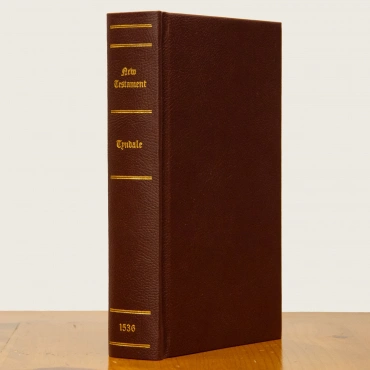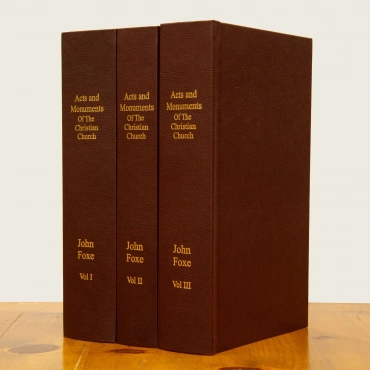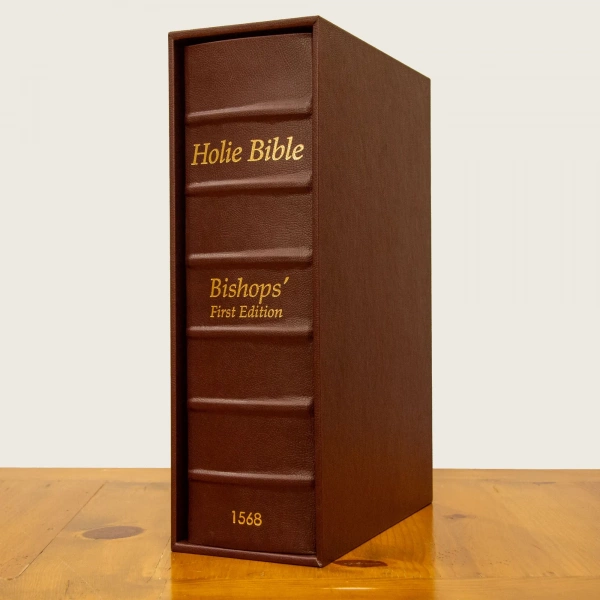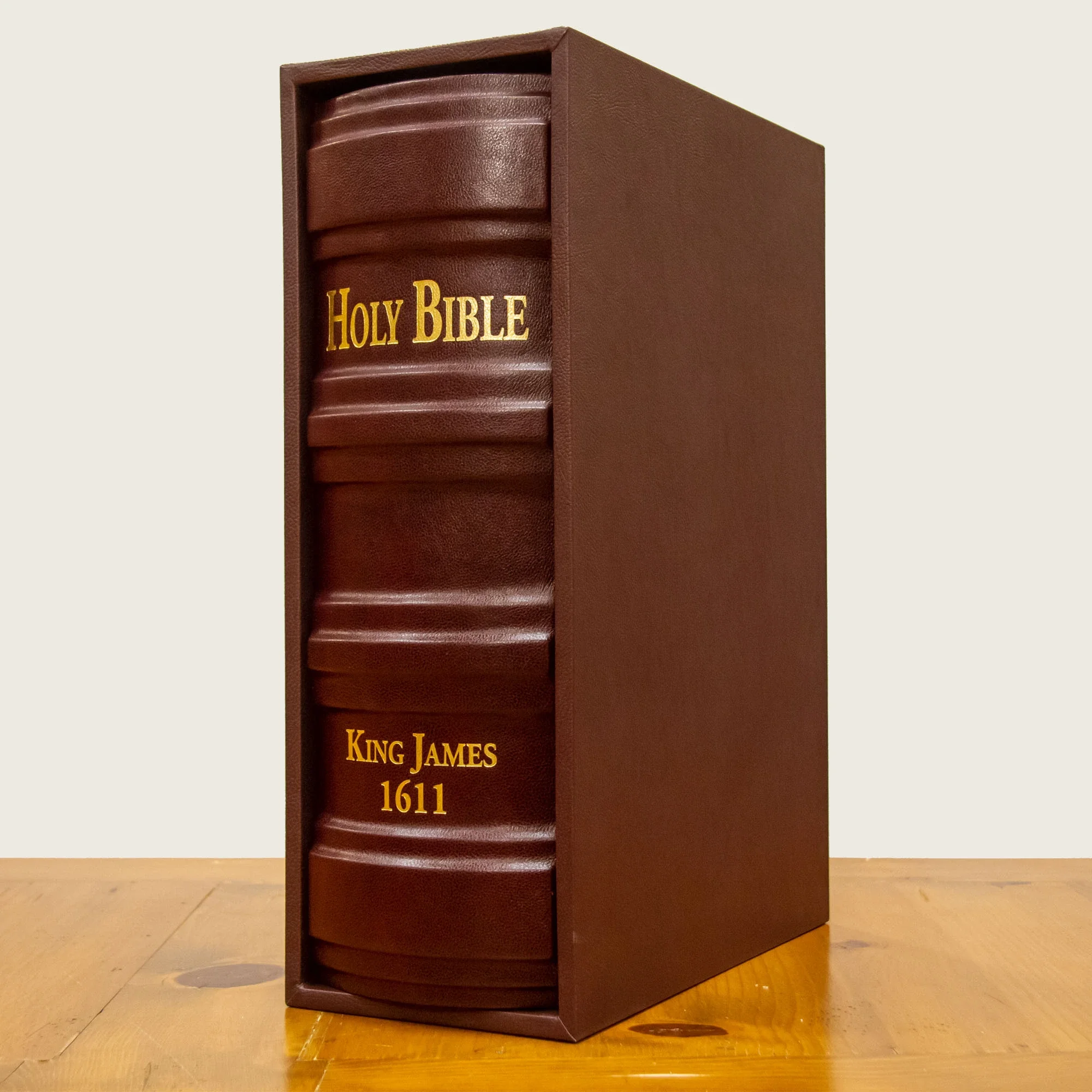A Bible can be antique, but not rare.
A Bible can be rare, but not antique.
A Bible can be both antique and rare, but not valuable.
However, what most collectors want, and what we almost exclusively deal in, are Bibles that check all three boxes: Bibles that are antique and rare and valuable.
So, how can you determine whether a Bible is antique or rare or valuable? First and foremost, you should only purchase from a reputable dealer. We here at The Bible Museum (GREATSITE.COM) have been the world’s largest dealers of rare and antique Bibles since 1987, and there are no other full-time professional rare book dealers who focus exclusively on ancient Biblical printings, and move a significant volume of such material, making our organization a “near monopoly” in this niche market for over 35 years.
That being said, we also strive to educate our customers so that they can be independently discerning in their evaluations of ancient Bibles available for purchase anywhere. A basic understanding of the natussre of antique Bibles and rare Bibles can provide a sense of empowerment for the buyer, which transcends being dependent upon trusting any dealer. As Sy Syms used to say, “an educated consumer is our best customer”.
Antique Bibles
Antique Bibles are also known as ancient Bibles, or old Bibles, or antiquarian Bibles. Sometimes we also see antique Bibles referred to by the more idiosyncratic term “vintage Bibles”, though that is inappropriate as “vintage” refers exclusively to wine. The age of a Bible is a major factor in determining not only its value, but whether it is legitimately an antique, or merely an out-of-print old edition.
An often asked question is, “How old does a Bible have to be, in order for it to be considered truly antique?” It is not surprising that people are confused by this because the standard of being “antique” varies greatly according to the type of material in question. Consider automobiles: if a car is as little as 25 years old, it is considered an antique. The standard is even lower for consumer electronics, such as computers, cell phones, audio equipment, or televisions, where items as little as 10 to 15 years old are antique, and items that are 25 to 40 years old are considered to be truly ancient.
Different Bibliophile Levels of Antique
Regarding Bibles, there are really different levels of “antique”. Let’s take a closer look at how a Bible’s age effects its defined antiquarian status in the world of dealers and collectors. We will see that while some kinds of rare and collectible books, such as “Modern Firsts” of classic works, may be considered antique even if they are just a few decades old, the standard for a Bible to be antique is much higher than that.
Bibles Up To 100 Years Old
We should clearly establish from the start that any Bible printed within the past 100 years is not an antique by any recognized professional use of the term. It is important to bear in mind that the Bible is the most printed book in the world, and by a very wide margin. For this reason, English language Bibles printed between the 1920’s and today, were generally mass-produced in such enormous quantity that they will never be particularly rare or valuable, and therefore the trade does not consider them to be antique in any meaningful sense.
In fact, within the rare book industry, Bibles that are less than a century old are often referred to as “Junk Bibles”. At first glance, this term can be highly offensive to Christians who mistakenly think the reference is a slanderous derogatory insult aimed at the Bible itself… but this is not at all what is meant. Rather, this is simply a reference to the fact that modern era Bibles of the past century as “as common as road gravel” due to the extremely high volumes at which they were produced.
Dealers are also frequently approached by people wanting to sell their great-grandparents’ Bible of the early to mid 1900’s, and it can be exhausting having to constantly tell these people that their cherished (though apparently not cherished enough if they want to sell it) old Family Bible which they think should be worth thousands of dollars, is in fact worth less than one hundred dollars… and often worth less than twenty dollars.
Bibles Between 100 and 200 Years Old
Bibles of the 1800’s to very early 1900’s are, as difficult as this is for many people to comprehend, still not old enough to be considered truly “antique” by most dealers. While not as common as their ubiquitous less than centenarian counterparts discussed above; they were still generally speaking, produced in fairly high quantities to fill the popular demand for Family Bibles in America throughout the days of Westward Expansion during the 1800’s and into the Industrial Revolution of the late 1800’s to early 1900’s.
There are of course some exceptions, such as special editions and first editions of historically important Bibles of the 1800’s… but these are few and far between. Rather than focus upon these rare exceptions to the rule, the general rule itself remains, that Bibles less than 200 years old are in most cases not of interest to dealers or collectors.
Antique Bibles of the 1700’s - Well Over 200 Years Old
We now begin in earnest, our discussion of truly antique Bibles. One distinguishing feature of most Bibles printed in the 1700’s (in contrast to older Bibles of the 1600’s and back) is that they were printed on wood pulp based paper, just as nearly all books today are still printed on wood pulp based paper. The advent of affordable books was due primarily to the ability to make paper cheaply from wood pulp, rather than from expensive cotton. This is why, prior to the 1700’s, it was generally only the wealthy who owned books. Once cheap paper production was possible, the “common man” could afford to have at least a modest library of books at home.
Another distinguishing characteristic of the antique Bibles of the 1700’s is the technological manner is which they were printed. Prior to the 1700’s, books were made using the tedious and laborious and expensive process of the movable type press, invented by Gutenberg in 1455. Each letter had to be laid into a tray like a jigsaw puzzle. During the 1700’s however, the leap forward to “stereotyping” was made. Whole pages were etched into a single sheet of metal. This was not only quicker and cheaper, but it also allowed printers to keep the etched metal plates and run off more copies of a book later, if desired.
These two advances: cheap paper and more efficient production, made books and Bibles an attainable part of everyday life for literate people living in the 1700’s or later, as opposed to being very costly luxury items and status symbols of the affluent owners of estate homes, as books and Bibles had been in the 1600’s and earlier.
From the standpoint of the rare Bible and antique Bible collector, there are two types of English language Bibles of the 1700’s. The first is Bibles printed in England in the 1700’s. These range from standard “quarto” size editions owned by individuals and families, to larger “folio” size editions, used by churches and seminaries on their pulpits and lecterns. The next, is the far more rare and potentially valuable, Bibles printed in America in the mid to late 1700’s. Put simply, Bibles printed in England in the 1700’s can be somewhat desirable to collectors, but Bibles printed in America in the 1700’s are extremely desirable treasures. This is mostly due to the fact that American Colonists of the 1700’s imported most of their Bibles from England, and the print shops of early America had more modest equipment, and less access to quality paper. As a result, American antique Bible printings of the 1700’s are rare and highly sought after.
Antique Bibles of the 1600’s & 1500’s
We must go all the way back to the 1600’s, and even to the 1500’s, to encounter the “First Editions” and the subsequent but still “Early Editions” of all the ancient Bibles in the English language. Whether it is the 1611 First Edition of the beloved King James Bible, or the 1568 Bishops Bible, or 1560 Geneva Bible, or 1539 Great Bible, or 1537 Matthew-Tyndale Bible, or 1535 Coverdale Bible… the era of the truly ancient Bibles is the 1500’s and 1600’s. This is where most rare and antique Bible collectors focus most of their attention, and resultantly, this is the type of material an antique Bible dealer will want to acquire as well.
The antique Bibles of the 1500’s and 1600’s were printed on expensive cotton paper, and made using the ancient movable type printing press equipment. These printings are therefore works of art. Typically printed in small quantities of not more than a few thousand copies, and with only a tiny percentage of those originals surviving the ravages of time; these Bibles are quite rare, as well as being ancient. An excellent overview of the history of each of these ancient translations of the Bible can be found by reading our brief illustrated English Bible History.
Rare Bibles
Having examined the definition of “antique Bible” in detail, we now turn our attention to what qualifies as being a “rare Bible”. This is a far more simple, straightforward concept. While age alone can eventually make something antique, in order for something to be rare, it needs to truly be scarce. There is often considerable overlap between antiquity and rarity, but the two are not the same. Likewise, age and rarity are components of value, but they do not necessarily equate to value.
Consider for example, a Bible that was a limited press run of just a few hundred copies, published by a ministry or Bible publisher, just a few years ago, or a few decades ago. That would be rare today… but it certainly would not be antique by even the most liberal of definitions. In all likelihood, it would also not be very valuable. Similarly, some secular publishers have produced “limited edition” Bibles within the past few decades. Clearly, a Bible can be rare without necessarily being antique.
This is why most collectors looking for historically important and valuable Bibles focus their search on the far more appropriate and accurate term “antique Bibles” rather than the relevant and related but not nearly as accurate term “rare Bibles”.
Valuable Bibles
Can a Bible be both antique and rare … and yet still not be very valuable? Yes, absolutely. That may seem counter-intuitive at first, but let’s consider this more carefully. Antiquity is attained simply through age. Rarity is attainted simply through scarcity. But for something to also be truly valuable, there has to be market demand for it. That demand generally implies particular historical relevance.
For example, there are antique Bibles of the late 1700’s, printed in England, that are not historically significant editions. They are merely generic King James Version printings of standard quarto size or smaller, with no special features, no illustrations, no commentary notes, typeset in a rather plain manner. They are unquestionably antique, and also fairly rare… but… who cares? They do not represent an important edition, or even a particularly aesthetically desirable edition. If they are in good shape, by virtue of the fact that they are late 1700’s Bibles, they will be worth at least a few hundred dollars… but not thousands of dollars. These type of Bibles are often picked up by the person on tight budget who just wants to own a very old Bible, and that’s great, but it is not really of interest to the serious collector.
Even among Bibles that are ancient and rare and valuable, we still see that market demand, which we might also refer to as general popularity, can dictate price in a way that is unexpected to many. An example of this would be the current market value of a 1611 King James Pulpit Folio First Edition Bible, which is generally $150,000 to $450,000, even though there are close to 200 of these extant today, making them only moderately rare. In contrast, a 1560 Geneva Bible First Edition would have a market value of closer to just $75,000 to $125,000, in spite of the fact that there are not more than a dozen of them extant today! Ironically, the far less rare Bible is worth far more. This is for one simple reason: the market demand for the beloved and immensely popular 1611 KJV Bible far outstrips the market demand for the less well known 1560 Geneva Bible… even though the 1560 Geneva Bible very historically important, and about twenty times as rare, and 51 years older than the 1611 KJV.
Another aspect that could potentially disqualify an antique and rare Bible from being valuable is condition. No matter how old or rare a Bible is, if it is not complete, or not in good condition, its market value will be severely negatively impacted. Given two antique Bibles of the same edition, if one is missing several pages and has cropped headlines and heavy oxidization, that less desirable copy might fetch only one-tenth the price of the one in more pristine condition. More details on this can be found by reading our helpful Antique Bible Buyer’s Guide.
Original Source: https://greatsite.com/antique-rare-valuable-bibles/







